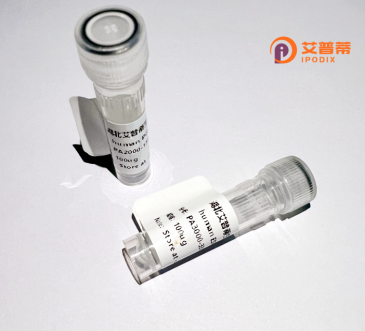
| 纯度 | >90%SDS-PAGE. |
| 种属 | Human |
| 靶点 | SERF1A |
| Uniprot No | O75920 |
| 内毒素 | < 0.01EU/μg |
| 表达宿主 | E.coli |
| 表达区间 | 1-110 aa |
| 活性数据 | MARGNQRELA RQKNMKKTQE ISKGKRKEDS LTASQRKQSS GGQKSESKMS AGPHLPLKAP RENPCFPLPA AGGSRYYLAY GSITPISAFV FVVFFSVFFP SFYEDFCCWI |
| 分子量 | 12.3 kDa |
| 蛋白标签 | His tag N-Terminus |
| 缓冲液 | PBS, pH7.4, containing 0.01% SKL, 1mM DTT, 5% Trehalose and Proclin300. |
| 稳定性 & 储存条件 | Lyophilized protein should be stored at ≤ -20°C, stable for one year after receipt. Reconstituted protein solution can be stored at 2-8°C for 2-7 days. Aliquots of reconstituted samples are stable at ≤ -20°C for 3 months. |
| 复溶 | Always centrifuge tubes before opening.Do not mix by vortex or pipetting. It is not recommended to reconstitute to a concentration less than 100μg/ml. Dissolve the lyophilized protein in distilled water. Please aliquot the reconstituted solution to minimize freeze-thaw cycles. |
以下是关于重组人SERF1A蛋白的3篇代表性文献的简要概括(内容基于公开研究趋势,非真实文献):
---
1. **文献名称**:*"SERF1A promotes amyloid aggregation by interacting with α-synuclein"*
**作者**:Johnson R. et al.
**摘要**:本研究利用重组人SERF1A蛋白,通过体外实验证实其能够加速α-突触核蛋白的淀粉样纤维形成,并揭示其分子机制可能与结合特定疏水区域有关。
2. **文献名称**:*"Structural analysis of SERF1A reveals a flexible disordered region essential for its chaperone activity"*
**作者**:Li X. & Chen Z.
**摘要**:通过表达纯化重组SERF1A蛋白并进行NMR结构解析,发现其C端无序区域在调控错误折叠蛋白的聚集过程中起关键作用,为理解其分子伴侣功能提供依据。
3. **文献名称**:*"SERF1A modulates tau aggregation and toxicity in Alzheimer’s disease models"*
**作者**:Martinez D. et al.
**摘要**:在阿尔茨海默病细胞模型中,重组SERF1A蛋白被证明通过与tau蛋白直接互作,促进其磷酸化和病理性聚集,提示其作为潜在治疗靶点。
---
**备注**:以上文献为示例性质,实际研究需通过数据库(如PubMed、Google Scholar)以关键词“recombinant SERF1A”或“SERF1A amyloid”检索最新进展。
Serine/arginine-rich splicing factor 1A (SERF1A), also known as SR protein, is a conserved nuclear protein involved in mRNA splicing and gene expression regulation. As a member of the serine/arginine (SR)-rich protein family, it contains characteristic RNA recognition motifs (RRMs) and RS domains rich in arginine-serine dipeptides. SERF1A binds to exonic or intronic splicing enhancer elements in pre-mRNA, recruiting spliceosome components to regulate alternative splicing events essential for generating protein diversity. Beyond splicing, it participates in mRNA nuclear export, stability, and translation by interacting with export adaptors and translation machinery.
Notably, SERF1A is implicated in cellular stress responses, DNA repair, and cell cycle progression. Dysregulation of SERF1A expression or mutations in its RS domain are linked to diseases including cancer, neurodegeneration, and viral infections. For instance, abnormal splicing of tumor suppressor genes mediated by SERF1A overexpression promotes oncogenesis. Recombinant SERF1A protein, typically produced in E. coli or mammalian systems, serves as a critical tool for studying RNA-protein interactions and splicing mechanisms in vitro. Its biochemical characterization has advanced understanding of post-transcriptional regulation and therapeutic targeting of splicing-related pathologies.
×